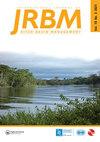日本河流景观的顺序河岸植被变化
IF 1.9
Q3 WATER RESOURCES
International Journal of River Basin Management
Pub Date : 2023-10-20
DOI:10.1080/15715124.2023.2273843
引用次数: 0
摘要
摘要裸露的砾石河床是日本河流中游常见的景观特征。如今,由于植被的入侵,它们正在消失。利用1946年、1975年和2010年的航拍影像,对日本各地河流中游河岸带的植被覆盖度进行了调查。然后将其与水文和水质记录、水坝和堰的位置、周边地区的居住条件、沉积物产量和上游山区的森林覆盖率进行比较。在过去的70年里,河岸植被覆盖率大幅增加,从接近0增加到30-40%。草本植被盖度高于乔木植被盖度。总植被覆盖度与水质参数不相关。植被覆盖度与上游流域产沙量呈显著负相关,与流域最大洪峰流量呈轻微负相关。与堤间陆地面积分数呈正相关。在水坝或堰的下游2公里范围内,截流泥沙的河岸植被覆盖率较高。这些结果表明,上游供给的砾石质沉积物在洪水期间沉积在中游,而不是洪水冲刷,是导致植被覆盖度偏低的主要原因。自第二次世界大战以来,重新造林减少了向中游河道供应的粗沙。这种重新造林,加上开采砾石和用水坝和堰截流泥沙,使河岸地带的植被覆盖率最近有所增加。人为干预可以通过减少河道输沙量来影响河岸带的植被状况。关键词:河岸植被砾石河道泥沙产量森林人为干预免责声明作为对作者和研究人员的服务,我们提供此版本的已接受稿件(AM)。在最终出版版本记录(VoR)之前,将对该手稿进行编辑、排版和审查。在制作和印前,可能会发现可能影响内容的错误,所有适用于期刊的法律免责声明也与这些版本有关。10. 数据可用性声明作者高度赞赏并声明,只要合理要求,每个人都可以获得数据。本文章由计算机程序翻译,如有差异,请以英文原文为准。
Sequential riparian vegetation alteration in Japanese river landscapes
AbstractBare gravel bed channels have been a common landscape feature of the middle reaches of rivers throughout Japan. They are disappearing these days because of vegetation colonization. Vegetation coverage of the riparian zones in the midstream reaches of rivers distributed throughout Japan was investigated using aerial photo images taken in 1946, 1975, and 2010. It was then compared with hydrological and water quality records, locations of dams and weirs, residential conditions of the surrounding areas, sediment yields, and forest coverage of the upstream mountainous areas. Riparian vegetation coverage has substantially increased in the last 70 years, from nearly 0 to 30-40%. Herbaceous vegetation coverage is higher than tree coverage. The total vegetation coverage did not correlate with water quality parameters. However, vegetation coverage had a significant negative correlation with the upstream basin's sediment yield and a slight negative correlation with the maximum flood peak flow rate. It was positively correlated with the terrestrial area fraction between levees. Riparian vegetation coverage was high within the 2 km downstream of dams or weirs, intercepting sediment flows. These results indicated that the gravelly sediment supplied from the upstream and deposited in the midstream at flood time has been the major contributor to keeping the vegetation coverage low rather than flushing by flood water. Reforestation since World War II has reduced the coarse sediment supply into the midstream river channels. This reforestation, together with gravel mining and intercepting sediment flow by dams and weirs, has caused the recent increase in vegetation coverage of the riparian zones. Human intervention can affect the vegetation conditions in riparian zones by decreasing sediment supply to river channels.Keywords: riparian vegetationgravelly river channelsediment yieldreforestationhuman interventionDisclaimerAs a service to authors and researchers we are providing this version of an accepted manuscript (AM). Copyediting, typesetting, and review of the resulting proofs will be undertaken on this manuscript before final publication of the Version of Record (VoR). During production and pre-press, errors may be discovered which could affect the content, and all legal disclaimers that apply to the journal relate to these versions also. 10. Data availability statementThe authors highly appreciate and state that data will be available for everyone upon reasonable request.
求助全文
通过发布文献求助,成功后即可免费获取论文全文。
去求助
来源期刊

International Journal of River Basin Management
WATER RESOURCES-
CiteScore
6.00
自引率
4.00%
发文量
48
期刊介绍:
include, but are not limited to new developments or applications in the following areas: AREAS OF INTEREST - integrated water resources management - watershed land use planning and management - spatial planning and management of floodplains - flood forecasting and flood risk management - drought forecasting and drought management - floodplain, river and estuarine restoration - climate change impact prediction and planning of remedial measures - management of mountain rivers - water quality management including non point source pollution - operation strategies for engineered river systems - maintenance strategies for river systems and for structures - project-affected-people and stakeholder participation - conservation of natural and cultural heritage
 求助内容:
求助内容: 应助结果提醒方式:
应助结果提醒方式:


